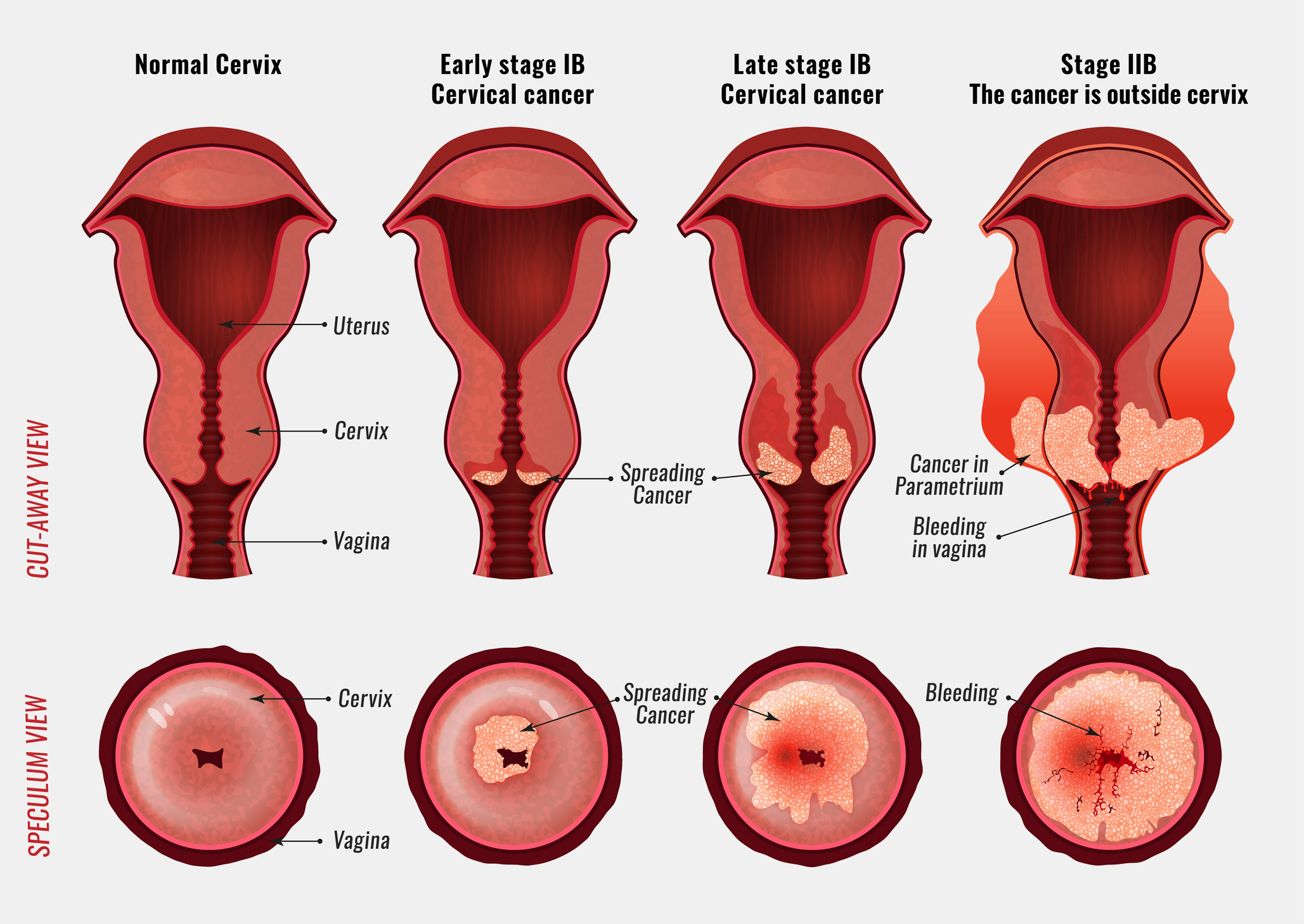ABSTRACT
Cervical cancer is a major public health problem affecting middle aged women, particularly in developing countries. Nowadays, homoeopathy, as a complementary system of treatment, is gaining popularity in treating cancer. Homoeopathy is used as an adjuvant therapy to minimize the side effect or physical suffering of conventional therapies. Identification of high risk populations and early screening is found to be effective in early recognition and treatment. The most prognostic feature of this cancer is that it is preventable and curable in the early stages. Homoeopathy is based on holistic approach and by the process of individualization it plays an important role in prevention and management in all stages of cancer.

KEYWORDS: cancer, homoeopathy, complementary medicine, risk factors
ABBREVIATIONS: Human papillomavirus (HPV)
INTRODUCTION
Carcinoma of cervix is the fourth most common cancer in women, ranking after breast cancer, colorectal cancer and lung cancer. It has the fourth highest mortality rate among cancers in women [1].Human papillomavirus (HPV) infection is the major causative factor for cervical cancer [2]. Other risk factors include weakened immune system, having multiple sexual partners, smoking, multiple childbirths, being sexually active at young age, using oral contraceptives for a long time [3].
In early stages of cervical cancer due to precancerous changes patients typically do not produce signs or symptoms. Symptoms may develop when the cancer cells start to invade surrounding tissues. Clinical manifestation of advance stages of cervical cancer includes intermenstrual bleeding, contact bleeding, pelvic pain, pain during sexual intercourse and unusual and offensive discharge from the vagina.
Uncontrolled division of the cells of the cervix leads to development of cervical cancer. Pap test and human papillomavirus test are typical screening procedure. Staging of cancer is important because it aims to assess the extent to which it has spread in the body at the time of diagnosis. The stage of cancer, his to type, age and immune system of the patients are some of the deciding factors which affect the prognosis of the case and treatment options such as surgery, radiotherapy, chemotherapy, or combination of these and palliative therapy in the late stages. All this treatment process can produce various side effects, such as nausea, difficult urination and bowel movements, skin irritation, hair loss, fatigue, infertility, early menopause.
The gradual progression of disease brought about by imbalance of vital force, are the cause of clinical manifestation of the cancer at the local level. Cancer is challenging as the patients presents with a paucity of symptoms which is nothing but only common and general symptoms. But with the help of thorough case taking, careful prescribing it can bring back the imbalanced pathos-physiological frame of the individual.
HOMOEOPATHIC APPROACH
The Homoeopathic approaches to treat cancer in two ways, firstly in prescription on the basis of individualization through totality of the symptoms of the person. Secondly, it plays a key role in supportive care and as integrative medicine in offering safe and effective way of managing cancer and to combat the side effects of conventional therapy. Homoeopathic medicine selected on the basis of individualization and symptoms similarity stimulate the body’s own natural healing powers to fight against cancer or improve mental, physical, emotional and social well-being. Cancer cases diagnosed in late stages also can be controlled with appropriate treatment and palliative care with the help of homoeopathic medicine. It is cost-effective also as it helps to reduce the health-care burden on hospitals, government policies.
MIASMATIC APPROACH
Homoeopathy believes in hereditary miasmatic dyspraxia being responsible for hyper susceptibility towards diseases. In cancer, the patient remains hereditarily susceptible to develop cancer and when they are exposed to carcinogenic influences, carcinogenic substances merely act as exciting factor in a patient having pre-cancerous predisposition. If we can correct the hereditarily or acquired miasmatic dyspraxia with the help of our constitutional anti-miasmatic medicines, we may be able to prevent cancer at least to some extent. The success depends on the stage of the disease and the efficiency of the physician to administer constitutional medicines judiciously in appropriate potencies and doses.
To consider cancer as an incurable disease just by its name and biopsy report, is not the principle of homoeopathy. “TREAT THE PATIENT AND NOT THE DISEASE’’ is the basic principle of homoeopathy and cervical cancer is no exception to this principle. There is no doubt that cervical cancer is one of the most difficult diseases to treat and cure, but that is due to its nature of growth, distant metastases and various alarming complications. Otherwise, it is to be treated in the same way as any other chronic diseases. In living human being, all physiological processes are continuously taken place in harmonious way. In cancer, this harmony is lost and it appears that a chaotic state is prevailing in the system and the cell are dividing and growing of their own without following the normal sequences of events. We know whenever and wherever chaos prevails, destruction is generally the outcome. In homoeopathy, we believe syco-syphilis is the miasmatic state responsible for chaos and destruction in the system. Naturally, to take care of cancerous chaos and destruction, we are to take the help of anti-sycotic, anti-syphilitic and mixed miasmatic drugs as and when necessary. Now a days, in most cancer cases, we are to face a mixed miasmatic state. Hence, mixed miasmatic drugs are often used for constitutional treatment and also for symptomatic palliation. However, a probable list of following medicines for treatment of cervical cancer are given below [4,5,6,7]:
- IODUM: This remedy is indicated in cancerous degeneration of the cervix particularly with profuse hemorrhage. There is intolerance of heat with intense restlessness and apprehension; in spite of ravenous hunger and much eating there is emaciation of the whole body.
- KREOSOTUM: This remedy is often used in cancer of the uterus, especially of cervix, with hardness, burning and sensitiveness; there is rapid emaciation with reduced vitality. There is putridity and acridity of all the discharges. This remedy is useful in sympathetic vomiting (irritation start from uterine cancer).
- SECALE CORNUTUM: Highly affective for controlling persistent and offensive bleeding in cancer and gangrene of uterus. A peculiar indication of this remedy is that offensive discharge from uterus causing her vomit. Cachectic state with irritable and nervous temperament.
- ELAPS CORALLINUS: A chief indication of this remedy in Cancer uteri with sensation as if something burst in womb, followed by a continuous stream of dark-colored blood on attempting to urinate; flow profuse, venous black discharges containing clots; pruritus vaginae.
- CURARE: Funnel shaped ulcer of so uteri, with corroding, ichorous, foetid discharge, smarting in vulva and thighs, shooting and digging pains in womb.
- CARBO ANIMALIS: This remedy is often used in cases of cancer of uterus with burning pain down the thigh. Cancerous ulcers are surrounded by hardened tissues which are bluish or red; neck of uterus is indurated with thin, acrid, offensive discharges and burning pain. Indicated in lowered vitality after debilitating disease.
- ARSENICUM ALBUM: This remedy is used in cases of uterine cancer, with burning pain in uterine region and shooting, stinging pains in upper part of abdomen; periodicity is very marked especially the time modality with characteristic burning pain which is relieved by heat. There is prostration with restlessness and anxiety.
- NATRUM CARBONICUM: There is induration of neck of womb, os uteri out of shape; pressing in the hypogastrium towards genital organs, as if everything would come out. Indifference with great nervousness and anxiety.
- MUREX PURPURA: Carcinoma uteri, with great depression of mind; pain in uterus as if wounded by a cutting instrument; lancinating, throbbing pain in uterus; acrid discharges, causing pudenda and thigh to swell and become raw, burning and itching; faintness and “ all gone’’ feeling in epigastrium.
- LACHESIS MUTUS: Uterine cancer developing itself at climaxes; pains increase rapidly until relieved by a profuse discharge of blood; coughing or sneezing causes stitches in affected parts.
- HYDRASTIS CANADENSIS: It is indicated in cancer and cancerous state with erosion and excoriation of cervix.
- GRAPHITES: It has restrained the growth of cancer in the cervix uteri, when there was burning and putrid bloody discharge.
CONCLUSION:
Owing to the magnitude of threat cancer imposes on health, immediate action needs to be taken. Although cancer can be effectively managed by homoeopathic medicines, sufficient evidence needs to be produced in order to justify the efficacy and superiority of homoeopathy in such incurable disease conditions.
REFERENCES
- Arbyn M, Weiderpass E,Bruni L,et al. Estimates of incidence and mortality of cervical cancer in 2018: a worldwide analysis.The Lancet Global Health. 2019 December 04; 8 (2): 191-203.
- Ault KA. Epidemiology and natural history of human papillomavirus infections in the female genital tract. Infectious diseases in obstetrics and gynaecology. 2006; 2006 Suppl: 40470. Available from: https://pubmed.ncbi.nlm.nih.gov/16967912/[Accessed on 12/10/2020].
- Muñoz N, MorenoV, Bosch FX,et al. Effect of oral contraceptives on risk of cervical cancer in women with papillomavirus infection: the IARC multi-centric case-control study. The Lancet. 2002 March 30; 359(9312): 1085-92. Available from: https://www.thelancet.com/journals/lancet/article/PIIS0140-6736(02)08150-3/fulltext#%20 [Accessed on 12/10/2020].
- Bhanja KC. The Homoeopathic Prescriber.7th ed. Kolkata: National Homoeo Laboratory; 2012. p. 125-126.
- Lilienthal S. Homoeopathic Therapeutics. Reprint ed. New Delhi: B. Jain Publishers (P) Ltd.; 2011. p.113-117.
- Clarke JH. A Dictionary of Practical Materia Medica. New issue, with additions. Reprint ed. New Delhi: B. Jain Publishers (P) Ltd.; 1999. p. 177-545.
- Boericke OE. New Manual of Homoeopathic Materia Medica with Repertory. Third revised & augmented edition. New Delhi: B. Jain Publishers, (P) Ltd.; 2008. p.79-458.
About Author:
Dr Sneha Kumari
PG SCHOLAR DEPT. OF MATERIA MEDICA R.B.T.S. GOVT. HOMOEOPATHIC MEDICAL COLLEGE AND HOSPITAL





